Including some of the stinging insects hummingbirds encounter while they’re nectaring on flowers.
Black-chinned Hummingbirds have been nesting in my neighbor Shane Smith’s yard this summer and I’m pretty sure they’ve also been nesting in my trumpet vine and in one of my five catalpa trees. So for a couple of weeks now I’ve been watching for juveniles but all I’ve seen is adult males and females – mostly the latter.
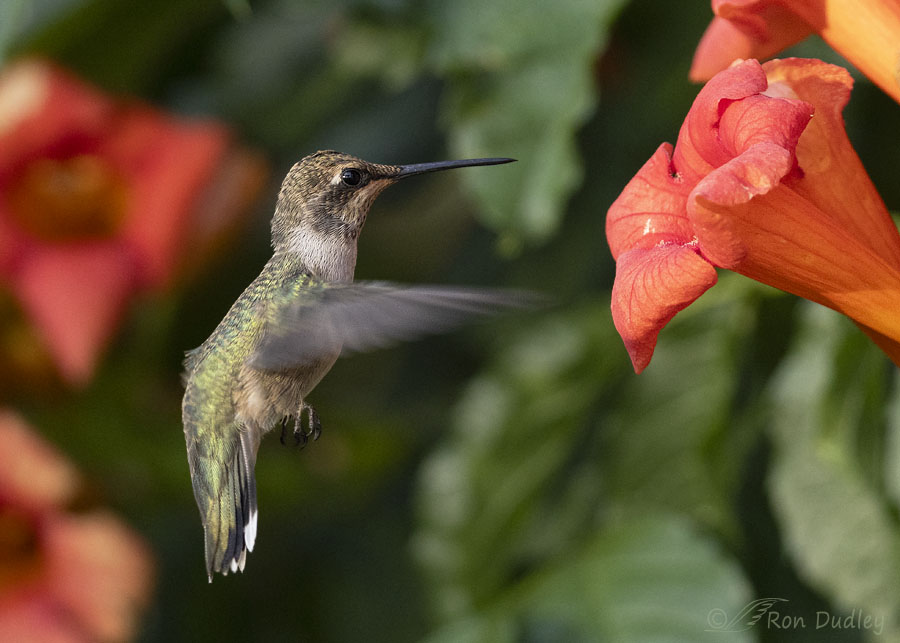
1/1000, f/5.6, ISO 2500, Canon R5, Canon EF500mm f/4L IS II USM + 1.4 tc, not baited, set up or called in
Until yesterday morning when this juvie male showed up. As you can imagine, I was tickled to see him.
In a recent post I complained about how bright the trumpet vine flowers were relative to the hummingbirds I’d been photographing and told readers that I planned to try photographing them very soon after sunrise in an attempt to mitigate the problem. So that’s what I did yesterday morning and it worked – the flowers weren’t so bright relative to the birds.
However, in the less-bright light it really slowed my shutter speed so in all of my shots of the hummers their wings were soft with motion blur. I really don’t mind implied motion of hummer wings in my photos, it’s just that my personal preference is to have them sharp.
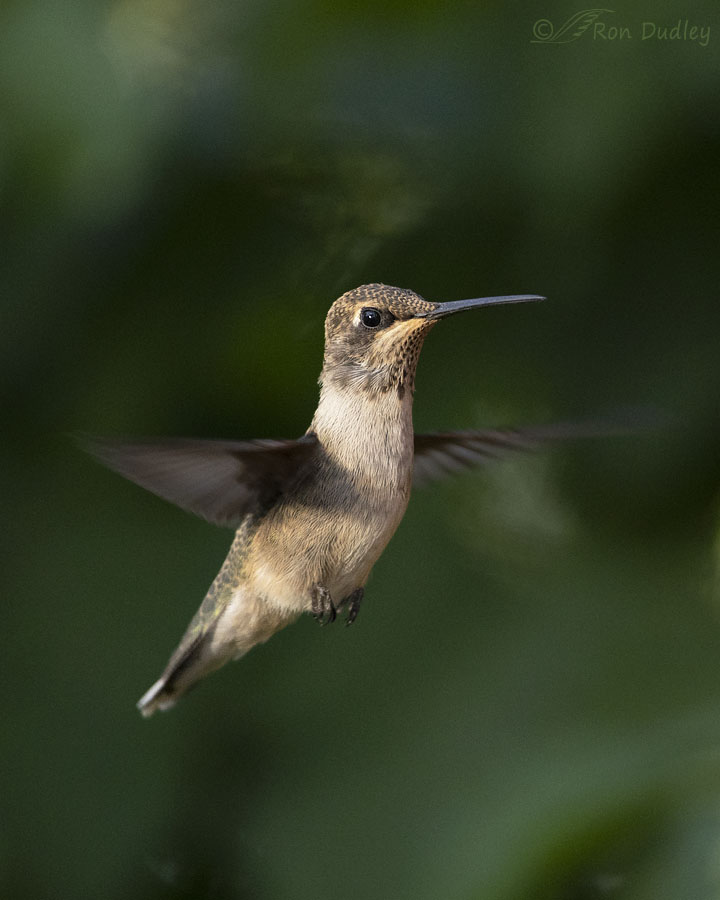
1/1250, f/5.6, ISO 2500, Canon R5, Canon EF500mm f/4L IS II USM + 1.4 tc, not baited, set up or called in
I’ll admit that I’m growing a little weary of seeing all of those bright red trumpet vine flowers in my photos, so yesterday I made several attempts to photograph the juvie male in flight with no flowers in the frame (after cropping.) This was my best result.
In a recent post we had a mini-discussion in the comments about whether hummingbird fear of stinging insects like bees and wasps is instinctive or learned. I leaned toward it being instinctive and yesterday morning, while I was watching the juvie male hummer, that suspicion was reinforced.
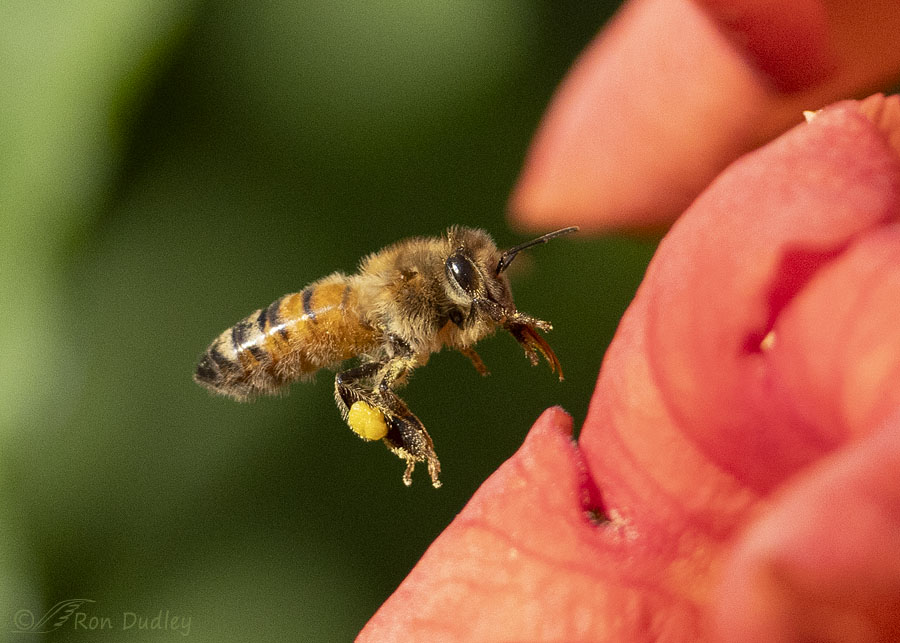
After a while I moved my lens a little closer to the vine in an attempt to get fairly detailed insect photos. I didn’t get any photos of the juvie male that included a bee or wasp but it was obvious that even at his very young age he had a healthy respect for stinging insects.
The number of honey bees at the vine seems to almost double from one day to the next and the young hummer behaved just like an adult in their presence. He avoided them, without exception while I was watching.
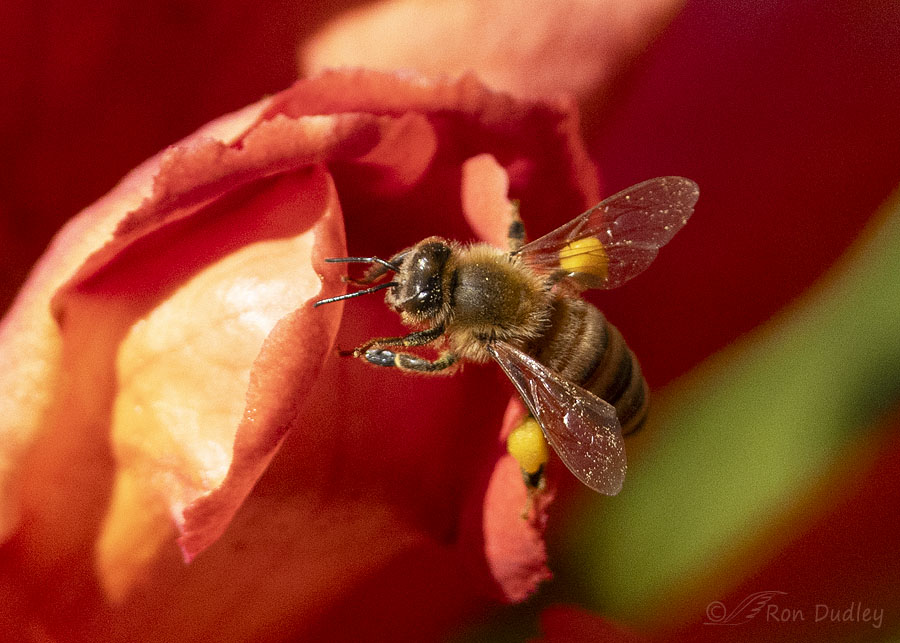
Most of the honey bees, and there were often dozens of them on the vine at any one time, had bulging pollen baskets.
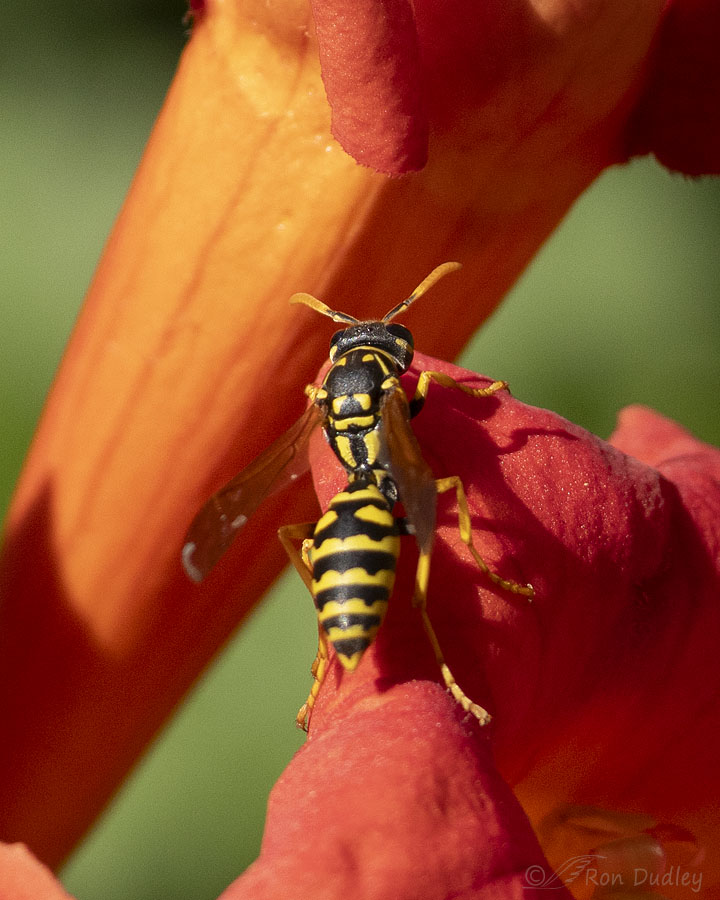
It was also apparent to me that the bees were avoiding the wasps. Many wasps view bees as potential food and will even attack their hives so the bees were giving the wasps a wide berth.
Recently I mentioned how shallow my depth of field is with my super telephoto lens and this photo documents it well. The wasp’s head and thorax are sharp but its abdomen is noticeably soft, due to a lack of depth of field.
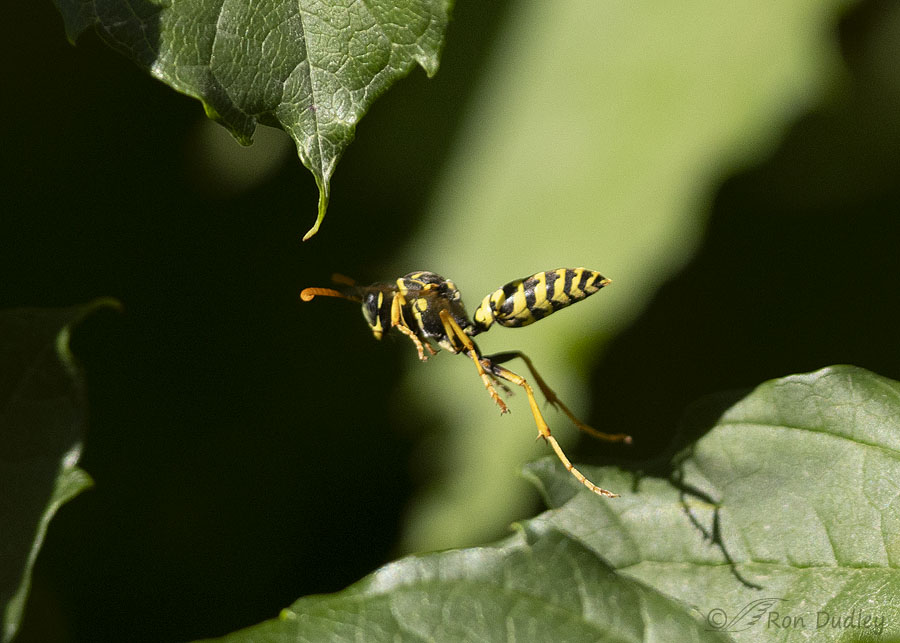
I’m always open for a photographic challenge so I decided to try to photograph one of the wasps in flight but the best shot I got, this one, wasn’t very sharp. I plan on trying again the next time I have good light on the trumpet vine.
For some reason wasps in flight give me the willies but I still enjoy seeing photos of them, in flight or not.
Ron


In late summer the yellowjackets take over our hummingbird feeder. They actively attack the hummingbirds. I put out wasp traps baited with sugar water or beer– they are quite effective in reducing their presence at the hummingbird feeder.
Kenneth, I put out a trap several years ago. It didn’t catch a single one.
A delightful and informative series. I would be observing the bees and wasps from a considerable distance too – and am glad to have the ‘birds eye view’ that you photos give us.
Thanks, EC.
Very nice series. I really like the first photo and the wasps are paper wasps and are usually very calm in behavior. I have many of the little black wasps on my flowers this year, few honey bees. I am enjoying the cute fuzzy hover flies and dragon flies in my yard this year. We use to have so many but they have declined the last 20 years. So this year is a treat to have them again. I have had a few juvenile hummers arrive last weekend and one adult rufous yesterday. The wars in the yard have intensified tremendously. Mostly early mornings and after 6pm it’s a war zone. This summer I have had a couple of male black-chinned and one male broadtail along with a great number of females. I have 4 feeders at the four directions in my yard. I was thinking yesterday I should get out and try for hummingbird photos. I have been staying home the last few days to help if Eric needed anything after his wisdom teeth extraction. His was a complicated procedure but went better than we expected. They took some of the jaw bone out, which will fill back in slowly, but luckily did not have to break his jaw on the one side. We are waiting to see if he has nerve damage, so far part of his face and tongue are tingly but he is also still very swollen on that side. He is in good spirits and that is a good sign.
Best of luck to Eric! That sounds like a grisly procedure.
My very best to Eric. Himself’s jaw was broken in a similar procedure and he had slivers of bone emerging for some time but it can good in the end.
Great shots! Loved the bee and wasp photos.
Thank you, Brett.
Super colorful shots! Love the brightness and activity capture from your yard and garden. Migrating Rufous are still here in N AZ – have to fill the 2c feeder every 15hrs! It’s a cacophony of fun on our deck. 🙂
I’m so jealous of all of your Rufous, Kathleen. I still haven’t seen one this season but friend April Olson reported seeing her first one yesterday. So there’s hope.
Super series Ron,thanks for sharing!
Charlotte Norton
Thanks, Charlotte.
Ron, since you don’t like the blurry wings, why not shoot in full manual so that YOU make the decision?
Thomas, for two reasons that I’ve explained several times before but you must not have seen them. I’m happy to answer the question again.
1. Every shooting mode has its advantages and disadvantages. I’m of the strong opinion that, whatever mode you choose, it’s best overall to use it virtually all of the time so you know it like the back of your hand. It becomes kind of like muscle memory. In the heat of the moment we make fewer mistakes that way. At least I do. I chose aperture priority long ago and I prefer to stick to it.
2. I prefer having full control over ISO, especially because for me, motion-blurred hummer wings are no big deal. For these shots I was already shooting at ISO 2500. I sure didn’t want to give my camera the option of going to some astronomical ISO. If I want to do that, I’ll make the decision, not the camera. I can make that change quickly with just the turn of a dial. And because I always shoot in the same mode, all of my dials and buttons always do the some thing so I do less fumbling around. I sort of specialize in action shots so fumbling around isn’t my friend.
Ron, got it on #1. It’s why I get tripped up when I don’t shoot in Manual.
As far as #2 is concerned, I recommend shooting in straight Manual (ie, no Auto ISO) for exactly the reasons you outline in your reply. Sorry, I didn’t make myself clear. 😁
Nice on the hummers even if you did have to settle for a slower shutter speed – like of like trying to get black and white birds in focus….. 😉 Good to have alternatives when you can’t get out in the field.
How do you determine what’s a juvenile? Lack of color perhaps?
Wasps are something I avoid – had a dog chase one up my pant leg as a teenager and tho I (fairly) rapidly got the jeans off I still got stung multiple times….. 🙁
“How do you determine what’s a juvenile?
Judy, in the case of Black-chinned males it’s the “black chin” and throat beginning to come in. I think of it kind of like a 5 o’clock shadow. I’d have more trouble with juvie females.
That second photo sans flower is a nice portrait.
Enjoyed your insect photos as well. Was wondering why the insect in flight shots looked so strange to me. I then realized it was because the moving wings are almost completely indiscernible in the photos.
“I then realized it was because the moving wings are almost completely indiscernible in the photos.”
Yup, I’m sure that’s it, Michael. It happens to some degree even with the hummer photos but when the wings are transparent the effect is exaggerated.
I really enjoyed the shots of the bees and their bulging “pollen
baskets” ! Objectively speaking, the wasps are handsome critters,
but I can’t REALLY be objective about them– once stung, you never forget, and I’m glad to know that the hummers have good
instinctive fear of both them and bees–no matter how ancient it probably is, I wonder how they developed it, being as their ancestors, once stung, probably died immediately ?
died before their offspring were even conceived ?
“died before their offspring were even conceived ?”
Very possibly, Kris. But the “stinging insect-tolerant” genes would be weeded out because they wouldn’t be passed on to the next generation. Over time, voilà – hummers who are less tolerant of stinging insects.
Hate the wasp. A quick google search revealed these synonyms for waspish: irritable, fiery, peevish, irascible, petulant, snarky, crabby, ornery, spiteful, etc. Also, of course, the great pics remind me of that horrible invention, the corset, so women can have the desired “wasp waist.” However, after indulging in my own ornery remarks I am enjoying the shiny geometrically pleasing markings on the body – I have never noted or appreciated these before. So my crabbiness is somewhat tempered. Thanks Ron.
“the great pics remind me of that horrible invention, the corset”
Your comment brought a chuckle, Frances. You make a very good point.
Ron, is right. An excellent point. And I suspect that corset wearers were waspish.
Love these photos! I especially like the portrait of the Hummer without the flowers. I personally prefer blurred wings on hummingbirds photos because it’s how you see them I’m real life and it gives the photograph more of a real humming bird vibe. So that photo is a total success – in my very humble opinion!
Thanks, Joanne. Your “very humble opinion” is appreciated.
Outstanding Ron. Love the full of pollen bee shots and including the wasps makes it even more interesting. The shots of the bees are really sharp and I did not notice the soft lower part of the wasp. My eyes went to the sharp upper half and would not have noticed had you not mentioned it. All very interesting. We have two bird baths out back that all the wasps use for their water supply. Good to see you taking a short rest from travel.
“Good to see you taking a short rest from travel.”
Everett, I’ve enjoyed the change but I haven’t been in the field for so long I’m missing it. I hoped to go today but I have an early afternoon appointment with an appliance repairman so I didn’t dare take the chance that I’d miss him.